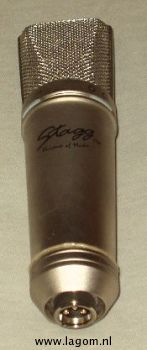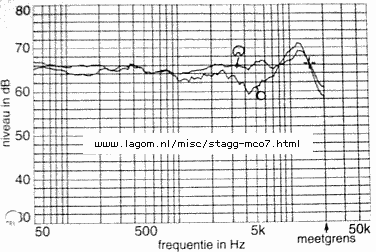Stagg MCO-7 microphone specifications
The Stagg MCO-7 is a large-membrane condensor microphone that was
available on the Dutch/European market for a while around 2001. This
page provides a bit more information about the microphone.
Manufacturer specifications
(From a copy I got from my vendor (Stand-by, Utrecht, Netherlands)
when I purchased mine)
- Type: pressure gradient mic. with FET pre-amp
- Cartridge with 1 inch large dual diaphragm
- Pattern (switch): omnidirectional / cardioid
- Output impedance: 200 ohms
- Sensitivity: 12 mV/Pa = -38 dB (0 dB = 1 V/Pa)
- Frequency response: 30 Hz--20 kHz
- Max SPL: 125 dB (1% THD @ 1000 Hz)
- Equivalent noise level: 20 dB (A-weighted, IEC 268-4)
- High-pass filter (switch) -6 dB/oct @ 100 Hz
- External phantom power: 48 V DC
- Current consumption: < 3 mA
- Dimension: 50 mm dia x 190 mm
- Colors: charcoal grey mat (MCO-7BK) or chromium metallic (MCO-7W)
Review 1
The Dutch magazine Gitarist published a rather enthusiastic
review in January 2001. The text of the review is available in Dutch, but you'll have work around
an annoying redirect on that web site (switch off javascript). Here are the
main points of the review:
- Recommended sales price (for a new microphone in 2001):
NLG 535 (EUR 250). A shock mount is
available for NLG 39 (EUR 18). Stagg is a brand name of the Dutch
company EMD, whose products are manufactured in Asia.
- It is an imitation of the Neumann U-89 microphone, which costs 9 times
more. Discrete electronics, balanced output, well-dimensioned transformer,
switchable between cardioid or omni pick-up pattern, all very nice. This
type of microphone is suitable for studio recordings where high quality
sound and low coloring is important. It is less suitable for live
performance (sensitive to feedback, fragile, etc.)
- The frequency response curve (below), as measured by the reviewer,
is typical for a large-membrane
microphone. Note the small increments in the vertical scale. Maximum
sound pressure: 102 dB at 0.5% THD, which means that you shouldn't put it in
front of a trumpet or drum. Compare this to 134 dB for a Neumann.
Review 2
Also available in Dutch from the link above. By Luc Henrion, "Meet Music
magazine 08/2000". Summary:
The manufacturer-supplied numbers should not be taken too seriously. The
microphone looks similar to the Neumann U-87. In comparison with an Audio
Technica 4033 (large-membrane cardio, around 500 EUR): similar response;
some difference in clarity in the 10--15 kHz range; response up to 20 kHz
(better than the 16.6 kHz from the specs). The sound is slightly less bright
(maybe more natural). The signal level is 6 dB lower than the AT4033. The
noise level seems to be slightly worse than the AT.
Listening test: voice, brass instruments, piano, violin, guitar,
percussion. Overall very good results, both in omni and cardio mode. The
piano results were slightly less, the brass instruments were excellent.
My opinion
I'm a bit skeptical regarding subjective listening tests as in the
second review. The noise/distortion figures and the frequency-response curve
are by far the best indicators for the sound quality of audio components. In
addition, for microphones and loudspeakers, one has to look at the response
curves at different angles. Large-membrane microphones typically do not have
a flat off-axis response, which makes them less suitable for uncolored
recording of physically wide sound sources.
I am certainly satisfied with the sound quality. However, I had to get
it exchanged in the store twice shortly after I bought it because something
broke in the electronics. After that, I stopped using the phantom power
supply of the same brand and upgraded to a mixer board with a built-in
phantom. I don't know whether it was the power supply, my old mixer, or
that I simply was unlucky, but since then it never gave any problems.
I must say that I don't use it very often because it is so big and
dependent on a power supply: unsuitable for making quick recordings
outdoors with a minidisc player. For that purpose I have a stereo pair
of good quality mini electret microphones. Maybe a bit noisier, but
infinitely more convenient.





